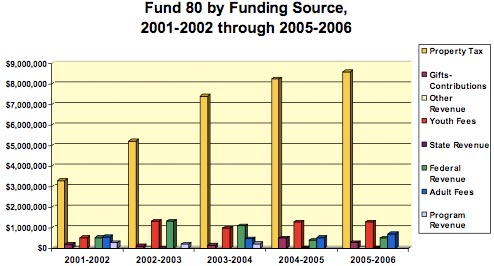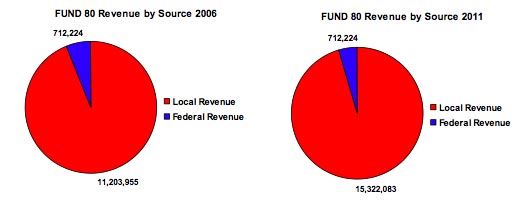In this morning’s Wisconsin State Journal there is a story that again misrepresents the place of Madison School Community Recreation and Fund 80 in the district and the community.
The chart comparing Fund 80 levies in Madison to those in other districts ignores the fact that most or all of those locales have municipal recreation programs paid for by municipal taxes. Due to a historical quirk, Madison has very little in the way of a municipal recreation department and programs and services that other locales fund via municipal or county taxes are funded and governed by the school district via Fund 80. In order to get a realistic comparison of Madison’s spending on recreational and community education programming one must look at total levies devoted to this. The last time I did this (early 2006) I found that the combined spending on MSCR and the Madison Parks Department was about $20 million. De Moines, IA (about the same size) has a parks and recreation budget of about $20 million. Ann Arbor, MI is about half the size of Madison and has a Parks and Recreation budget of $12 million. Green Bay, also about half the size has a Parks and Recreation Budget of $8 million. In other words, the spending in these areas is very much in line with what others spend.
There’s been no shortage of discussion on Fund 80 here. 2006 / 2007 Madison School District $333M+ Citizen’s Budget.
Related:
- Amy Hetzner: Community Service Levies Climbed Since Revenue Caps Lifted:
But once the Legislature removed the caps on the community service levies for the 2000-’01 school year and gave school districts an opportunity to keep their recreational activities from conflicting with educational programs, more took advantage of it.
“I think – when you look at districts across the state – that’s really what caused the jump,” said Art Rainwater, superintendent of the Madison Metropolitan School District, which in 2005-’06 had the largest community service levy in the state.
Like some of the bigger community service funds, Madison’s supports a full recreation department with adult and youth programming. But it also helps pay for television production activities, after-school activities, a gay and lesbian community program coordinator and part of a social worker’s time to work with low-income families, Rainwater said.
The School District’s community service levy is expected to grow to $10.5 million in the coming school year. In contrast, the same levy for Milwaukee Public Schools – which serves nearly four times as many children in its educational programs – is expected to reach $9.3 million, said Michelle Nate, the district’s director of finance.
Although the state Department of Public Instruction has issued guidelines to school districts on how they should use their community service levies, it leaves it up to local residents to decide whether their school boards do so wisely and legally. - Carol Carstensen: Fund 80 is Worth our Support.
- Lucy Mathiak: Community Service Fund 80, Can We talk?
- Ruth Robarts: A Tale of Two Budgets: the Operating Budget for Madison Schools versus its Budget for Community Programs and Services
- A look at the City of Madison’s parcel count growth.
The charts are from Lucy Mathiak’s post:



Perhaps there’s more room for funding parks and rec at the levels cited for those cities because they have lower per-pupil spending for their schools (per-pupil spending data from Standard and Poors’ School Matters site – 2004 numbers: Des Moines’ 3 school districts: $7,455, $6,862 and $8,516, respectively; Ann Arbor, $10,764; Green Bay’s 3 school districts: $7,683, $9,093 and $9,266, respectively; MMSD, $11,702).
I would certainly favor a more conventional governance structure for rec funding which would hold decision makers directly accountable for why administrative costs for MSCR are 34% of its $9.9 million budget (per the numbers in last year’s Citizen’s Budget), how much of the programming subsidies actually help those in financial need, rather than those who aren’t, and to justify the expense of using four-color printing glossy flyers and mailers to advertise programming.
According to the State Journal article, my tax bill as a homeowner will reflect a levy for Fund 80 of $9.9 million for 2006-07, increasing to $11.5 million for 2007-08. As long as discussion of Fund 80 is taken off the table or discouraged, I have no ability to weigh in on wanting less of my tax bill to go for subsidized art classes (a nice luxury, but a luxury nonetheless), and more of my tax bill to beefing up our law enforcement capability (a basic). Likewise, those looking for room in a homeowner’s checkbook to increase funding for schools need to consider that (a) future referenda would be more likely to succeed if the net effect on the tax bill can be made neutral, and (b) the lack of fiscal accountability and restraint shown by MMSD’s track record with Fund 80 speaks loudly and clearly about how school budgeting would be handled if revenue caps were lifted.